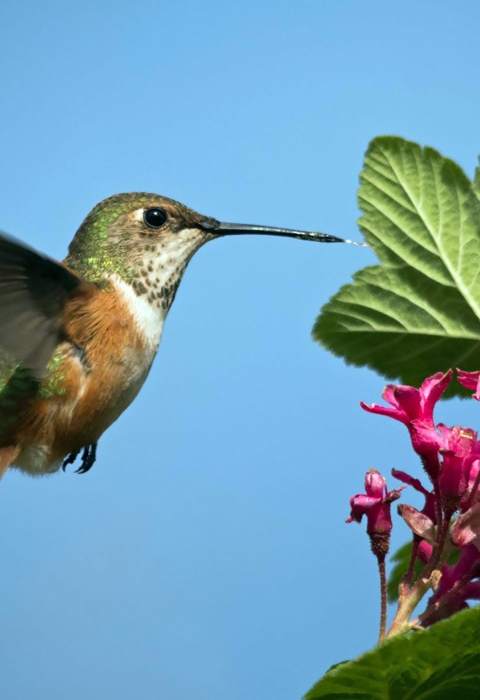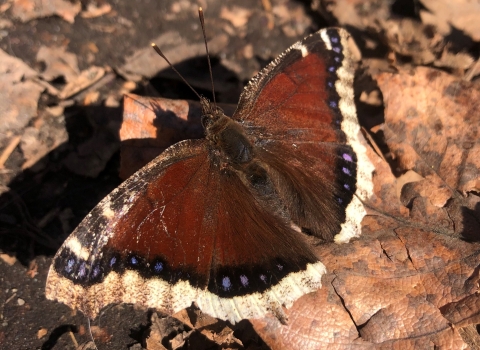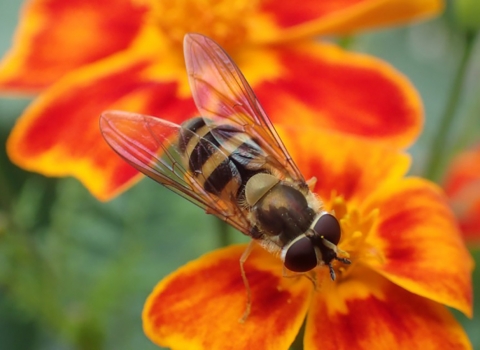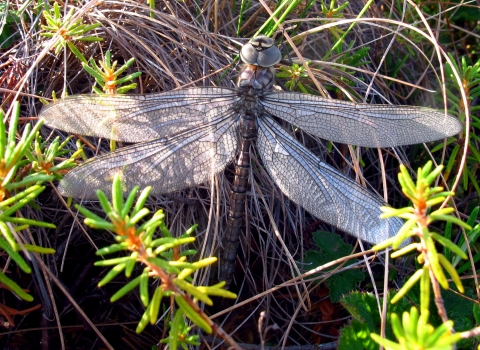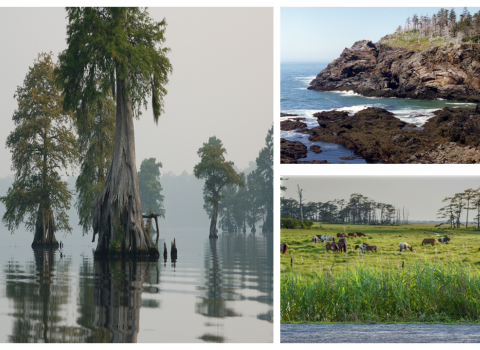Imagine standing 3 inches tall and weighing 3.5 grams (less than the weight of a nickel). Would you be bold and boisterous? Rufous hummingbirds are. Though they’re among the smallest hummingbirds in the world, these electric creatures zip across the landscape in an annual migration cycle that stretches north to Alaska and as far south as Mexico and Florida.
And, they do it in style.
Rufous males, with their brilliant orange neck-feathers, aggressively defend their territories. Guarding flowers and feeders, they’ll flash their gorget feathers in warning and chirp at other males.
If a female is present, the tone changes. The male rufous will flash its bright feathers, trying to impress her. If that doesn’t work, it’s time for the spectacular. Flying high in the air, the male rufous will perform an acrobatic J-shaped dive.
Following the flower trail
To power their tiny engines, rufous hummingbirds visit up to 5,000 flowers each day. In their 3,900-mile trip from the south, north to Alaska, and back, they let the flowers be their guide.
In the spring, rufous hummingbirds follow the Pacific flyway up through California where the flowers bloom early in the year. In May, they arrive in Southern Alaska to mate. Rufous hummingbirds are primarily found along the coast from southeast Alaska to the Kenai Peninsula. Resources are scarce at this time of year. There are only a couple of flowering species available.
They time nesting and feeding of young with the start of Alaska’s peak flower season. They feed on the nectar of salmonberries, fireweed, western columbines, yellow paintbrush, and other native flowers.
By the end of July it’s time to return south. These feisty fliers follow the mountain route out of the state, taking advantage of the later blooming alpine flowers of the Rockies. All along their looped journey, they pick up pollen from flowers and transfer it to others, helping the plants to reproduce.
Studying the spectacular
With their rapid movement, large migration, and tiny bodies, rufous hummingbirds present a unique challenge for scientists to study. While the range and population of rufous hummingbirds in Alaska is growing, there is so much we don’t know about how they live. What trees in Alaska do they prefer to nest in? Where are they migrating from exactly? How many hummingbirds successfully complete their winter migration and return to Alaska each year?
To start to answer these questions, scientists such as Kate McGlaughlin with the Alaska Hummingbird Project and Todd Eskelin at the Kenai National Wildlife Refuge prepare for years to handle these small creatures. For example, Todd had banded 25,000 to 30,000 birds before learning to handle a delicate hummingbird. There are only three hummingbird banders in the state.
Placing a uniquely numbered band on a bird and releasing it allows scientists to learn about where it travels and if it returns to Alaska. Because rufous hummingbirds are so tiny, their bracelets are exceptionally small.
Scientists catching and releasing hummingbirds across the country have re-captured a few of Alaska’s birds, and vice versa. Birds banded in Alaska by the Alaska Hummingbird Project have been recorded in California, Texas, and Colorado. They also recently recovered a rufous that was originally banded while wintering in Florida.
Knowledge leads to conservation
Through banding hummingbirds across their range, scientists have learned some alarming information. Each year, it is estimated that only 60% of hummingbirds survive their annual migration. Breeding is critical for population survival. Looking at population trends, there is a documented 60% decrease in rufous populations since 1974.
These birds are threatened by invasive species invasive species
An invasive species is any plant or animal that has spread or been introduced into a new area where they are, or could, cause harm to the environment, economy, or human, animal, or plant health. Their unwelcome presence can destroy ecosystems and cost millions of dollars.
Learn more about invasive species , climate change climate change
Climate change includes both global warming driven by human-induced emissions of greenhouse gases and the resulting large-scale shifts in weather patterns. Though there have been previous periods of climatic change, since the mid-20th century humans have had an unprecedented impact on Earth's climate system and caused change on a global scale.
Learn more about climate change , development, and pesticides. People around the country are working together to protect rufous hummingbirds, and scientists like Todd continue to study them to help fill key information gaps.
How can you help?
- Plant native flowers in your yard. Local plant nurseries are a great place to get native plant recommendations.
- Avoid using pesticides. Look for natural alternatives.
- If you live near the coast in southern Alaska, keep and maintain a hummingbird feeder (but only if you can commit to washing it at least once per week, to remove mold and bacteria). Fill it with 4-parts water and 1-part white sugar, nothing else. Be mindful that a feeder could attract bears.
In Alaska we are shared stewards of world-renowned natural resources and our nation’s last true wild places. Our hope is that each generation has the opportunity to live with, live from, discover and enjoy the wildness of this awe-inspiring land and the people who love and depend on it.
